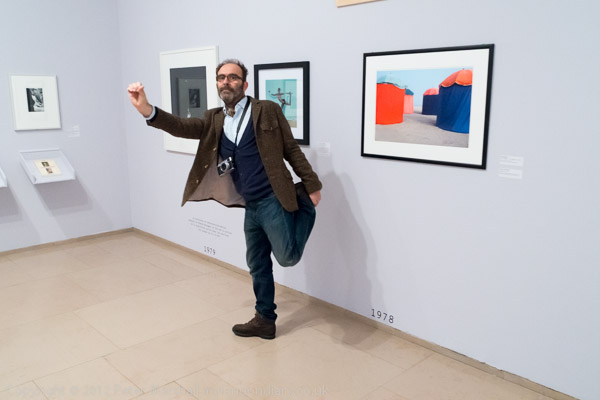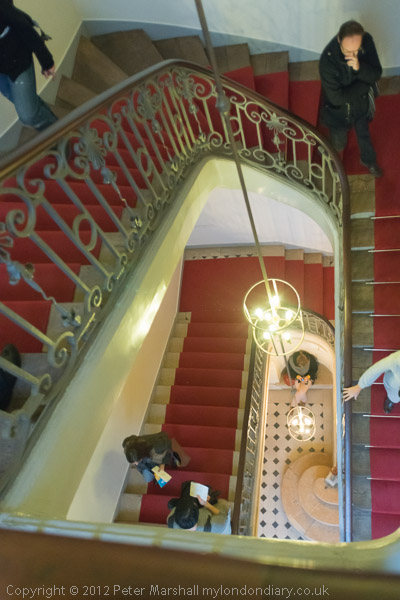Sunday I woke up not feeling at my best after a big meal the previous evening, but after a bit of breakfast felt a little better. Sunday mornings in Paris both Linda and I go separately to worship, she at the Protestant temple near the Louvre for the 10.30am service while I make my way to the Maison Européenne de la Photographie (MEP) in the rue de Fourcy in time for its 11am opening. Normally we then meet up for lunch.

The garden in front of the Maison Européenne de la Photographie (MEP)
Linda had already been to see the main exhibition at the MEP on the free opening they have on Wednesday evenings – when I was at Photo Paris. Photography in France, 1950-2000 was a large show which reflected both the changes in the medium and in society over the period and also the views of its two creators, Gilles Mora and Alain Sayag, who feel that photography is now past its peak, with the disappearance of much print journalism and the switch online to video.

I take advantage of a man posing in front of a picture for his friend
The show certainly seemed to me to catalogue a downhill journey, with the show being dominated by the work from the early years, with some memorable images. Perhaps Iziz was the star of the show, but he had firm support from Willy Ronis, Cartier-Bresson, Doisneau, Brassai and more, with some fine fashion work by Frank Horvat and William Klein, as well as a rather irrelevant image by Robert Frank, a Swiss-born photographer who became American – although of course the publication of his book Les Amercains in Paris was a major event in photographic history in France as elsewhere across the world.
There were a number of books including this on show in glass cases – and this reflected the intentions of the curators to show photography in a wider context than simply images, and the show included examples of photography used in magazine spreads and adverts, as well as a grid of images of the best pictures by an amateur photographer packed with the usual cliches – sunsets, snow, sun on the mountains and sunsets – and one that almost manages to make a decent image of two hens. Perhaps the weakest aspect as an exhibition was in the display of books – looking at their covers isn’t a great experience, and perhaps some short video displays would have been useful.
But even in these heady early days there are signs of the fatal viruses that worked themselves out in the lower floors of the show dealing with the later decades. This was a history of a medium subverted first by the easy nudes and chemical abstractions and later by the philosophical and the chic, meaningless art and the market for such decorations. The show demonstrates both the strengths of French photography and its weaknesses.
What seems most dated from this early period was the work of the ‘radical artists’ who now don’t appear at all radical, while the ‘reclamé’ or publicity images have aged much better and made a real contribution to the show. It would perhaps have been better to have had a show of this nature curated by outsiders to French culture who might have spared us some of the more banal images of the famous French – and personally I could have done without pictures of our royal occasion.
As the years progressed there was still some fine photography, though it sometimes became hard to find for the dross (my notes have a rather stronger term.) Most of the better work came from the photojournalists, and the rest of photography – with some notable exceptions such as DATAR seemed to have lost the plot. Even those whose work I admire were often represented here by rather poor examples of their work.
This was a show intended to provoke discussion, and it will probably be very successful at doing so; it continues until 13 Jan 2013.

As usual there were several other shows at the MEP, the most interesting of which for me was Susan Paulsen‘s intimate view made over 10 years of Wilmot, Arkansas, a small southern town which is a part of her family history and where some of her relatives still live.
I very much enjoyed looking at her pictures – finely made Epson Ultrachrome inkjet prints. They are very much seen from the perspective of her family, living in this town of 700 inhabitants, a town (at least for its white inhabitants) that used to be a place of “fine things, fine manners, fine ways.. a place where everybody spoke perfect English.” Changes came “in the 1960s; due to mechanisation many blacks were moving from the farms into town” and Paulsen records “I am proud of Uncle William and Big John for fighting … zoning restrictions” against setting up trailers (mobile homes) on the grounds that “trailers represent fairness to the very poor.”
The images chosen for the MEP web site show two portraits of black people in the nine images, giving a rather different view to the show as a whole. Although I went around enjoying the pictures, by the end I was also thinking it was a bit like comfort food and nostalgia and I longed for something with a little more edge.
You can see some of Paulsen’s older black and white work older b/w work here.
There were a couple of other shows down in the basement, neither of which interested me greatly. One featured the self-portraiture of teenager Sarah N. who, according the curator writing on the MEP web site “has produced a staggering body of photographic work” and the other by Jean-Luc Tartarin, undoubtedly a talented photographer – he was only 20 when he won the Prix Niepce in 1971, the youngest photographer to do so, and who now teaches photography at l’École Supérieure d’Art de Metz Métropole. You can see some of his work on line at Galerie Jean Greset and see him talking at one of his shows on YouTube. But the work for all its technical proficiency didn’t have anything to say to me.
You can take a very quick walk around all these shows in a 1 minute 26 second video by Molly Benn on Le Journal de la Photographie. She also covered other events in the Paris Month of Photography, notably on the evening of November 8th, which was the peak evening for openings in Paris this month – the Photo-Off brochure lists 25 of them, but there were also 5 others. She got on her bike and tried to take in all 30, but was defeated by the long climb up the rue de Belleville and abandoned her ride after only 19, but still an acheivement that makes my own attempts seem rather tame.
Of course I like to spend enough time at each venue to see the work properly, and also like to have a glass (or sometimes two) or wine, so even had I brought my bicycle (certainly the fastest way to get around the city) I could not have managed to come close to her record.
More pictures from Sunday in Paris on My London Diary shortly.